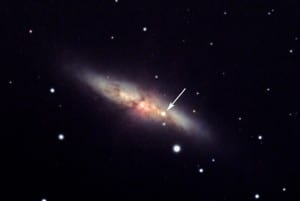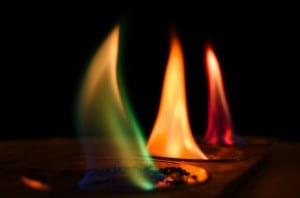On supernovae and serendipity
By Oli Usher, on 24 March 2014
Fresh from his discovery in January of Supernova 2014J while at UCL’s University of London Observatory, Dr Steve Fossey spoke about ‘Supernovae and serendipity’ at a Physics Colloquium on 12 March.
When introducing Dr Fossey, the observatory’s director Professor Ian Howarth explained how he wanted to set some facts straight.
The discovery of Supernova 2014J was no fluke, he said, and the press release that said it was a happy accident (written by yours truly) was wrong, along with all the coverage that followed.
Like all good jokes, this one had a large kernel of truth (so Ian, if you’re reading, no hard feelings!): even if first chancing upon the supernova was a stroke of luck, what happened next, both on the night of the discovery at UCL and in the days that followed at observatories around the world, was not.
I bring this up because the story of what happened after the discovery is in many ways more interesting than what happened on the night.
Supernovae, Dr Fossey explained, are all caused by a star becoming unstable and exploding, but the reasons for the instability, and the properties of the explosion, vary. And in those variations lie this one’s importance.
Although the popular view of astronomy is seen through the filter of multi-megapixel Hubble photos, one of the key tools that astronomers use does away with images entirely.
Instead of looking at pictures made up of millions of pixels – but where each pixel shows just a few colours– astronomers sometimes need to look at just a single pixel and break that one point of light down into thousands of colours. For this, they use instruments called spectrographs.
As any GCSE chemistry student knows, different elements are associated with different colours; copper, for instance, burns a brilliant green. Look at a copper flame through a spectrograph and the hue associated with that element stands out with a huge spike in intensity.
By pointing spectrographs at supernovae, astronomers in the mid-20th century found the celestial equivalent of the green flame in a school science lab. Different types of supernovae had different colour profiles, revealing different elements inside them.
One type, catalogued as ‘Type Ia’, was particularly odd: it contained no hydrogen – usually the main element in stars – but showed strong emission from silicon (the product of carbon and oxygen fusing together.).
This pointed the finger of blame at white dwarfs, the compact balls of carbon and oxygen left by Sun-like stars once they have expended their hydrogen fuel.
White dwarfs may be small, but their explosions are huge, Fossey explains: a Type Ia supernova is several billion times brighter than the Sun. And they have a very particular feature: their brightness is extremely predictable.
* * *
The two unusual properties of Type Ia supernovae (very bright, and very predictable) meant that cosmologists in the late 20th century recognised them as tools for probing the expansion of the cosmos.
Just as the apparent brightness of a streetlight can tell you how far away it is, so astronomers used the apparent brightness of these supernovae to measure distances in the cosmos, with the goal of finding out how the expansion of the cosmos was gradually slowing down over time.
To refine their measurements, Fossey explained, astronomers needed as many supernovae as possible, scanning the skies and searching for them in an increasingly industrial manner until they started finding dozens every week.
In the process, the astronomers found something very odd, which led three of them to win a Nobel Prize in 2011: faraway supernovae were fainter, and hence more distant, than expected, meaning that the expansion of the universe couldn’t be slowing. It was speeding up.
Cue frantic rewriting of textbooks and a fundamental revision of our understanding of the universe.

One scenario for Type Ia supernovae: a white dwarf accreting matter from a neighbour till it becomes unstable
Credit: European Southern Observatory
But throughout all this, something troubling remained. That Type Ia supernovae come from white dwarfs is clear, but what triggers them, surprisingly, is not.
It could be that the white dwarf pulls matter from a neighbouring star until it hits the critical mass and explodes. That theory would explain why they always appear to have the same brightness: the critical mass is always the same.
But they could equally be caused by two white dwarf stars colliding together – and that wouldn’t. And this, Fossey suggests, is troubling.
Given that our entire understanding of distance in the universe, model of cosmic expansion, predictions for the ultimate fate of space-time and inventory of the mass-energy content of the universe all rely on measurements of Type Ia supernovae, we might want to actually know for sure how they are triggered.
Which brings us back to Supernova 2014J. It’s very close; it may even be the closest Type Ia supernova seen since the invention of the telescope – meaning that observations offer quite literally an unprecedented scientific opportunity and a chance to put these troubling uncertainties to rest.
Not bad for a discovery made during a practical astronomy class.
 Close
Close



